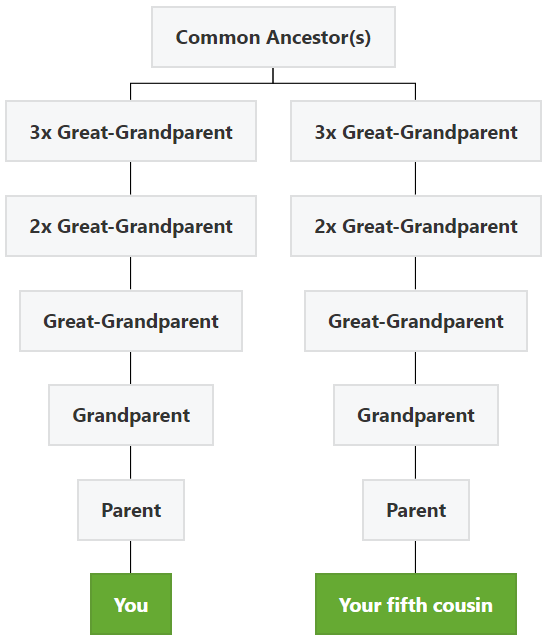Want to discover everything there is to know about fifth cousins? Then you’ve come to the right place. The bigger the family tree, the more tricky it is to tell how we are related to other people, and whether fifth cousins are blood relations.
We’re going to answer all the burning questions about this interesting side of your family tree, so you can understand it better.
How is a 5th Cousin Related to Me?
A fifth cousin is a relative who shares a set of great-great-great-great-grandparents with you.
To put it simply, a fifth cousin is a sibling of your great-great-great-grandparents. The number of cousins is a way of telling how many generations you both are from your common ancestor.
This basically means that second cousins share a great-grandparent, third cousins share a great-great-grandparent. Subsequently, fifth cousins share a great-great-great-great grandparent, marking what is the 6th generation in your family tree.

Are Fifth Cousins Considered Family?
Fifth cousins are classified as distant relatives. You and your fifth cousin share great-great-great-great-grandparents. To reach this common ancestor, each of you would trace back five generations. While they are part of your extended family, the generational distance makes fifth cousins seem more removed than closer relations such as second or third cousins. As the familial connections go further back, the sense of immediacy in the relationship often diminishes.
Are Fifth Cousins Blood-Related?
Fifth cousins are related, but there is a chance they do not share DNA. In fact, there is only a 10-15% chance of sharing genetics with any fifth cousin.
Even if you and our fifth cousin are related by blood, the DNA shared will be small, especially when compared to closer cousins. It is unlikely that you share identical DNA with your fifth cousin. You may be genetically related to each of your fifth cousins, but it is possible to not share DNA with any of them.
With at least one common ancestor, fifth cousins share at least one of their great-great-great-great-grandparents, but they are the descendants of the different children from this ancestor.
Fifth cousins do not share the same grandparents, this honor belongs to first cousins.
How many fifth cousins do I have?
You may want to think twice about inviting all your fifth cousins to your wedding since the average person has several thousand. You’d need to rent a stadium to fit them all in.
The exciting thing about exploring your family tree is discovering the sheer numbers involved in your wider family. Everyone has a unique story and is all part of the massive family story that makes up your rich history. All fifth cousins are descendants of your great-great-great-grandparents, and they would have lived in a world that was incredibly different from the world you live in today.
The next time you examine your family tree, try and consider the journey each member has been on, it’ll blow your mind!
What Does Fifth Cousin Once Removed Mean?
The child of your fifth cousin or the fifth cousin of your parent is known as a fifth cousin once removed. Two cousins that share a common ancestor but are not the same number of generations from great-grandparents are said to be “removed.”
Only cousins that are not removed are part of the same generation. Essentially, this means a first cousin is the child of your parent’s brother or sister. Your parents and their siblings are part of the same generation, in the same way, that you and their siblings’ children are.
No matter which cousin is in question, any cousin that is once removed is concerned one generation or above the other.
Therefore, your parents’ first cousins are your first cousins, but they are once removed because of the generation between you.
If your fifth cousin has a child, then this child would be once removed from you because you are a generation above them.
For fifth cousins, the most recent common ancestor once removed is the great-great-great-grandparent of a fifth cousin, and the parent of the fifth cousin once removed.
What Does Fifth Cousin Twice Removed Mean?
A “fifth cousin twice removed” denotes a two-generation gap between you and your fifth cousin. If the relative in question is two generations older than you, they would be from your grandparents’ generation. Conversely, if they are two generations younger, they would belong to the same generation as your grandchildren. The term “removed” specifically refers to the number of generational steps away from a direct cousin relationship.
What Is a Half-fifth Cousin?
Everyone has lots of half cousins, and can be determined as half-first, half-third, half-fourth, half-fifth, and even half-sixth cousins.
Multiple situations lead to two relations being half cousins. Generally speaking, half cousins share approximately half the DNA found in full cousins. We all have 32 sets of great-great-great-great-grandparents and those who share one set are fifth cousins.
If two people only have one person in common that is a great-great-great-great-grandparent, then they are known as half-fifth cousins.
Half cousins generally occur when one member of the family remarries and has children with another person. One grandparent can have offspring with two different people, making the offspring half-siblings, and half cousins.

